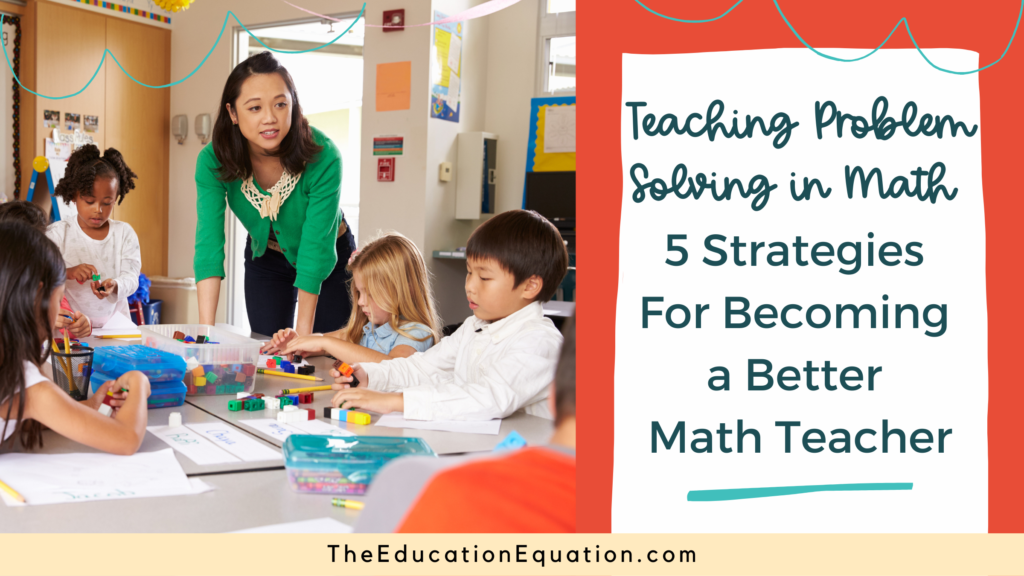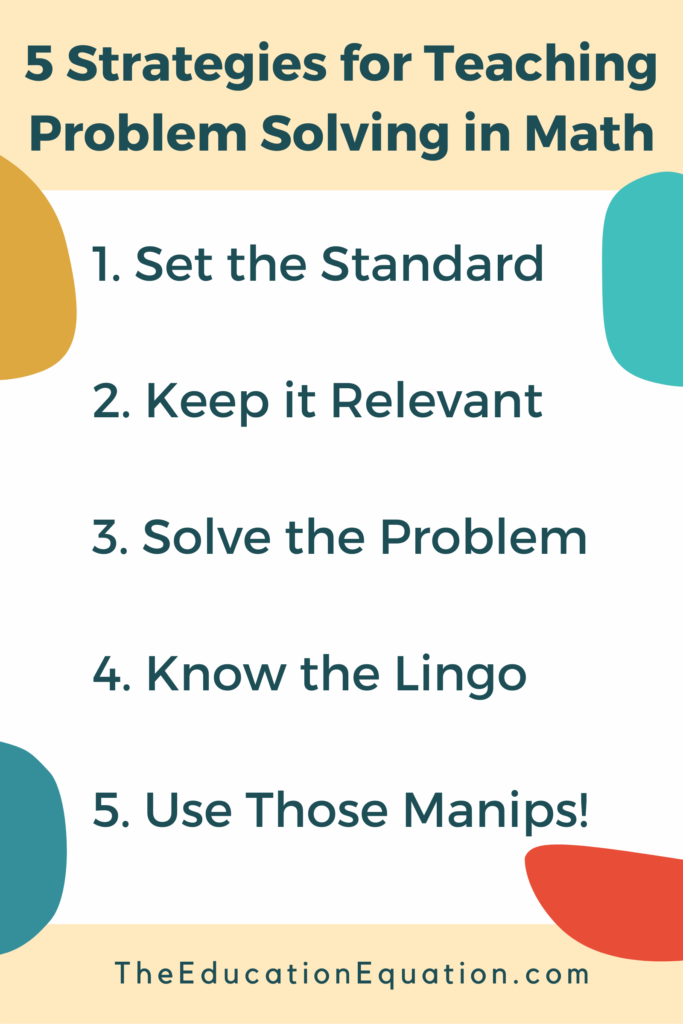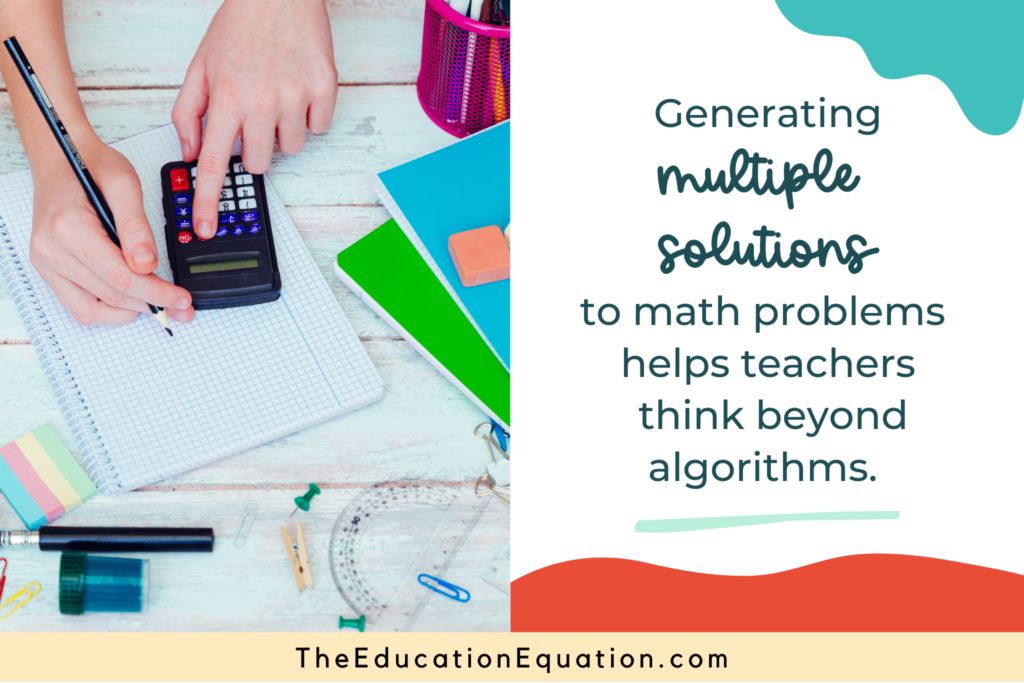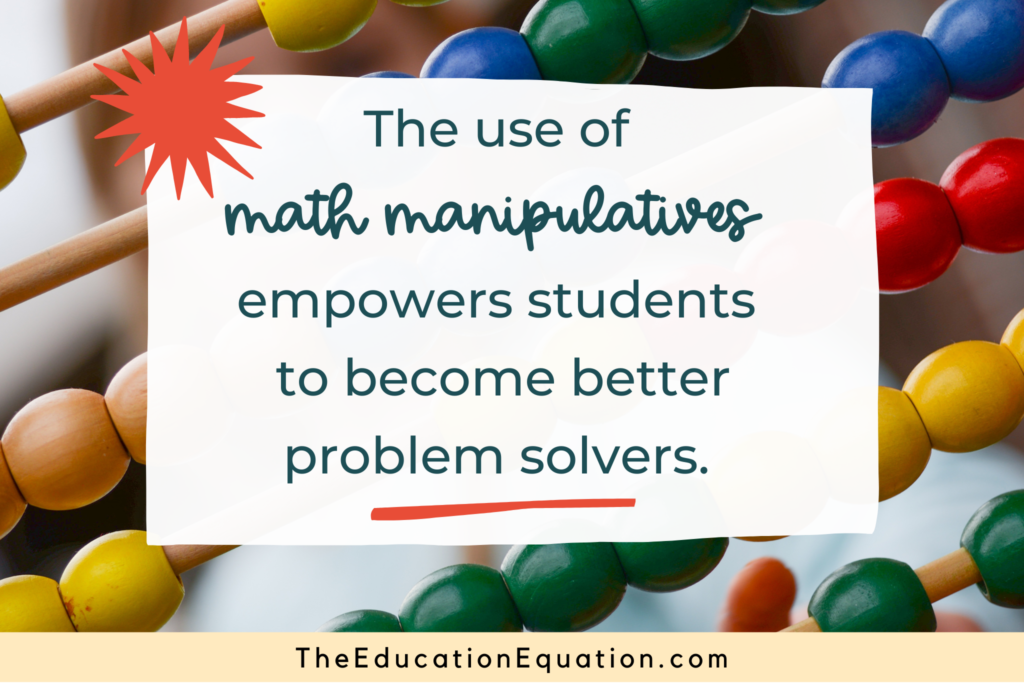Effective strategies for teaching problem solving in math have evolved since I started teaching 20+ years ago – and, for the better! More and more teachers, just like you and I, are using problem solving to teach math concepts in a way that invites students to be active participants in the learning process.

If we want to teach kids math – and do it effectively, we need to explore how we can plan and structure our lessons so that children get the chance to explore math concepts and talk about their mathematical thinking. Here are 5 effective math teaching strategies you can use to better support your students in learning problem solving in math.

1. Know Your Curriculum! Get to know your math curriculum before teaching problem solving in math.
Before you can plan and deliver a math lesson you need a clear learning goal based on the expectations or learning standards laid out in your school’s math curriculum. Now if you want to deliver an effective math lesson, then you also need to know the standards that came before and after your learning goal.
Why you ask? Well, every math concept you teach is part of a larger math continuum or trajectory of learning. This trajectory is the developmental pathway that most children follow when they learn a math concept (or any concept for that matter). The Curriculum documents are set up to reflect this.
When we see the bigger picture of what a math curriculum looks like across grade levels we can:
- review previous learning expectations before introducing new concepts
- make connections and build on previously learned math
- identify where students are in their trajectory of learning
- work on bridging gaps in learning for students that struggle
- see what we need to prepare students for in the years to come
Even after 20+ years of teaching I still use this strategy to better prepare myself for teaching math. Last year after spending the bulk of my career teaching grades 3 to 6 I found myself in kindergarten. Reviewing the curriculum to see what the kids would learn in grade 1 helped to inform my teaching. It helped me prioritize and make decisions around how in-depth I needed to go and how much time I needed to spend on different math expectations.
If you want to explore your math curriculum in greater depth check out your state’s math standards or (if you’re in Canada) your provincial expectations. Here are a few links you might find helpful:
Common Core: Mathematics Standards | Common Core State Standards Initiative (corestandards.org)
New York State Standards: Welcome to EngageNY | EngageNY
Ontario Math Curriculum: Mathematics (gov.on.ca)
2. Keep it relevant! Use real world math problems to teach math concepts.
If you teach children, then I’m sure you’ll agree that kids learn best when they can tap into learning experiences they can connect to. I mean, let’s be real here – we all learn better when we can relate to the material we are learning. Real-world math problems do just that by connecting math to everyday events relevant to your students’ lives, interests, and experiences.
When we use real world math problems to teach mathematical concepts we create valuable opportunities for students to:
- see math in the everyday events of their life
- use real-world contexts to help them visualize the math needed to solve the problem
- form deeper mathematical connections beyond rote memorization of math facts, algorithms, and formulas
You can even take your use of real-world math problems a step further and connect them to experiences and events happening in your classroom, community, or around the world.
3. Solve the Problem! Solve the math problem multiple ways before giving it to your students.
So you’ve come up with the perfect problem and you’re ready to see what strategies your students will use to solve the math problem. To best support your students with this process, I highly recommend taking a few minutes to see how many ways you can solve it yourself before giving it to your students.
Generating multiple solutions helps you to think beyond the algorithms and consider some of the strategies and tools your students might use when they attempt the problem. It allows you to see the math through fresh eyes. And when you can see the math, you will become better at meeting the learning styles and needs of all your students.

Knowing a variety of possible solutions before you teach your lesson sets the stage for you to:
- validate a variety of problem solving strategies used by students
- meet students where they are at in their trajectory of learning
- make connections between conceptual and abstract strategies more explicit for students
- analyze student errors and support students in seeing where they took a wrong turn
4. Know the Lingo! Be ready to use math vocabulary to talk about math with your students.
If our goal is to deepen our student’s understanding of the math they are learning through problem solving, we must encourage and support them as they learn to talk about math. One of the ways to do this is to brush up on our knowledge and use of math vocabulary.
You see, the more fluent we are in the language of mathematics, the better equipped we will be to model and guide our students in communicating about the math they are learning through problem solving.
Having a solid math vocabulary is important because it allows students to:
- talk about math with their peers using a shared vocabulary
- communicate more clearly about the strategies they used to solve the math problem
- ask more specific questions when understanding breaks down
As you expand your math vocabulary to support student learning, please remember: You don’t need to know it all!
Your level of comfort with using math terminology will grow over time and with experience. Don’t be afraid to refer to your teacher’s manual, math textbook, Google, or favorite resource for teaching math. I still refer to my favourite, Big Ideas from Dr. Small, to confirm definitions and gain deeper insight into the math I am teaching regularly. When I taught grades 4 and 5, I would even look up definitions alongside my students. I strongly believe this sort of modeling teaches students strategies they can use to become more proficient in math.
If we want our students to be literate in the language of math, we must prepare and support them as they learn to identify, label, and talk about math in the context of problem-solving.
5. Use those manips! Encourage math exploration through the use of math manipulatives.
The use of math manipulatives in k to 6 classrooms is one of my favourite ways to support students in problem solving for a wide range of math concepts. When students use manipulatives to solve a math problem, they can focus on a highly engaging form of math ‘play’ that is purposeful and goal driven. If we rely too heavily on step-by-step processes and rote memorization to teach mathematical concepts, we miss vital opportunities for even our strongest math students to make sense of math on a deeper, conceptual level.

The use of math manipulatives when learning problem solving in math provides:
- a fun and highly motivating way for kids to explore the math
- the freedom for kids to engage in trial and error
- the opportunity to explore the math by trying out multiple representations of the problem
- a concrete model of student thinking that can reinforce math concepts and confirm their ideas
When kids develop a strong conceptual foundation for math through the use of math manipulatives it empowers them to become more proficient and confident problem solvers
Want more math ideas, tips, and strategies for teaching problem solving in math?
If you’re still reading this, can I just say THANK YOU for reading my very first blog post! I truly hope you feel inspired to expand your teaching toolbox and try even one of the strategies I suggested.
If you want to learn more about who I am check out my About Me page or join me over on Instagram where I am sharing more math goodness! So don’t be shy – Say hello and let me know…What questions do you have about teaching math? What strategies have helped you to become a better math teacher? Which strategies do you already use or would like to try from this list?





